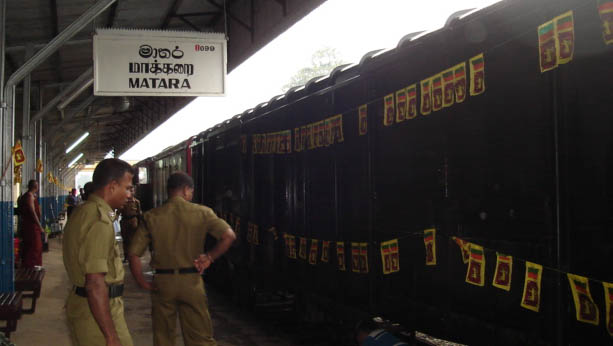
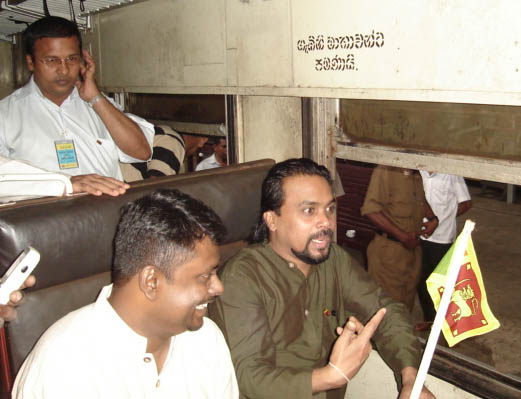
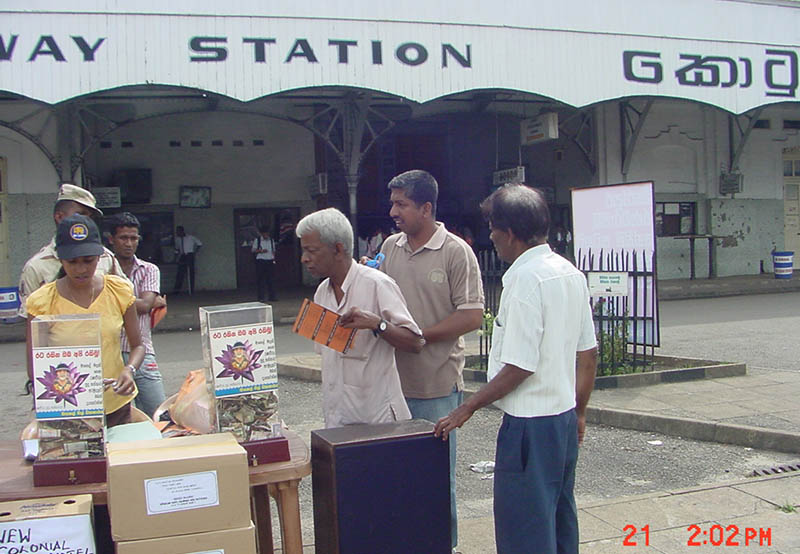
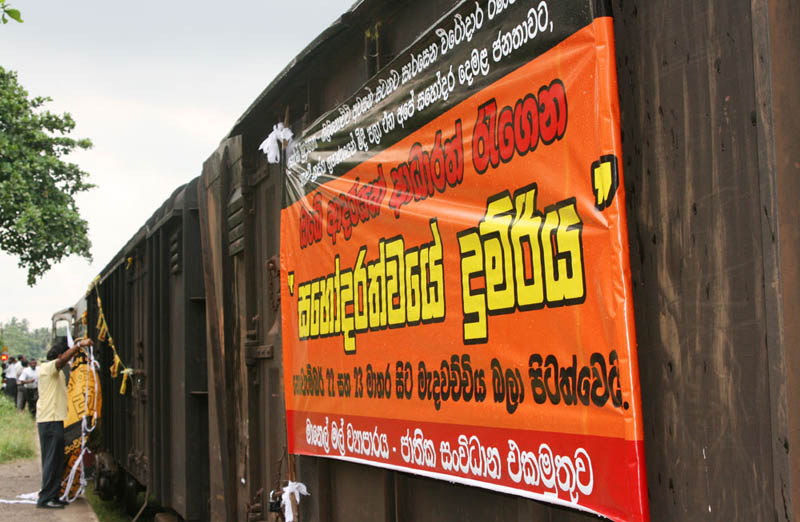

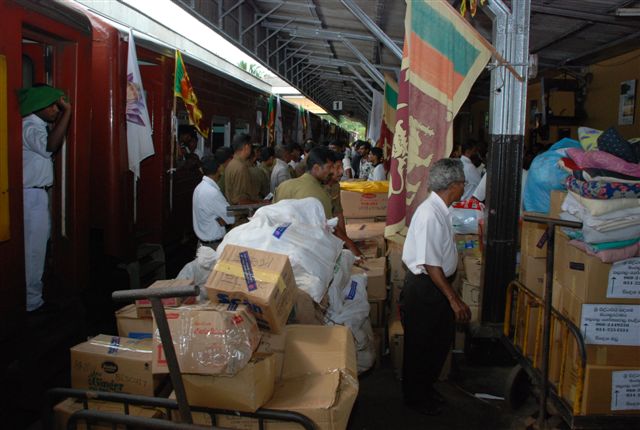
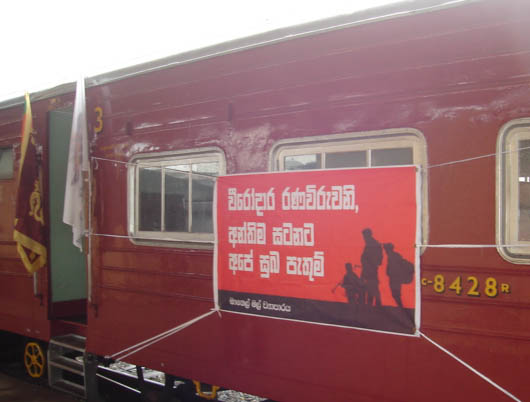
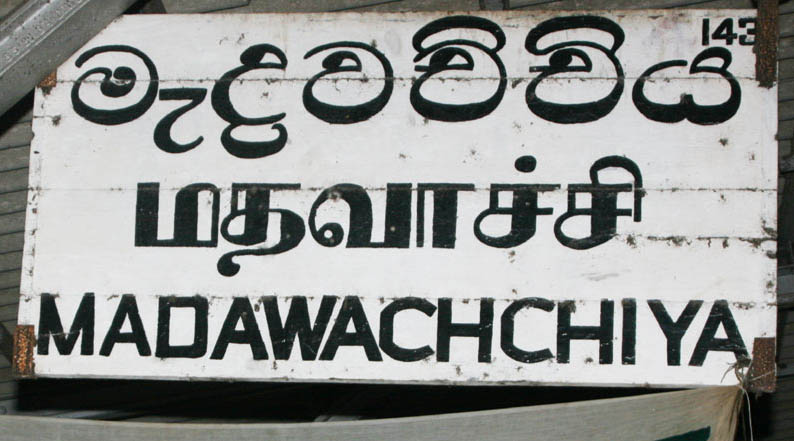
 |  |
 | 
|
 | 
|
 | 
|
The logistics of the "Train of Brotherhood", was done by the ManelMal movement led by S. L. Gunasekara, and the grass-roots organization was done by the National Freedom Front (NFF) under the leadership of Wimal Weerawansa. There was no attempt to canvas for large donations, but all attempts were made to collect as many small contributions as possible. At the collection stall open for 5 days in front of the Colombo Fort railway Station , even beggars were seen to come and contribute a few rupees, a poor school child may have contributed a bottle of water. The thought and the motivation to contribute was as important, as the contribution itself.
Leaving Colombo at 2:30 AM, we arrived in Matara just after 5 AM. The city of still a sleep and we could hardly find a place open to have a tea. The Train was expected to depart Matara at 6:50 AM, and the local organizers were already at the station and were arranging for the small function. The rail goods wagon had been decorated with Sri Lankan Flags. The collection from Matara had already been checked and loaded in. The wagon was attached to the train that arrived at Matara when the engine switched directions to return. After a short simple ceremony with few speeches by the organizer and some blessing from the Monks the train left around 7:30 AM. They were not expecting to make any collection at the short stops into Galle. However few people had come to the stations with contributions, which were checked and accepted. There was an unfortunate delay into Galle when some prankster had called in the Bomb squad.
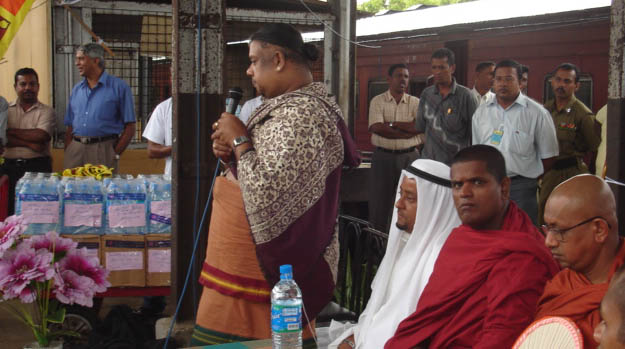 | 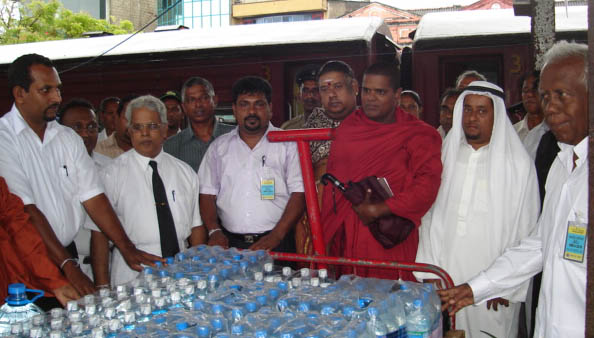
|
At Galle Railway Station the goods wagon was attached to a different train for the trip to Colombo. The Railway dept had given the use of two rail wagons for the trip. Each they told could hold 5 lorry loads. Delaying the train by 4 hours, these two wagons filled up during the trip into Colombo. The General Manager of Railways Dr. Lalithasiri Gunaruwan, joined the train at Moratuwa. He authorized two more rail wagons to be attached for collection the next day on the way from Colombo to Medawatchchiya. Almost filling these two extra wagons the train reached it's destination safely on Sunday evening, and the goods handed over to the Army for distribution, since it is not easy for a civilian organization to operate in those regions.
While the bulk of the collection will be distributed by the Army, the organizers S.L. and Anil wanted to distribute a token amount themselves. I therefore got an opportunity to visit IDP camps near Mannar on November 23rd, as I went along to report on the activity, like I had done of a visit to Vakarai a month ago (Sunday-Times 2nd Nov).
Leaving the train at Galle around 10 AM, we drove independently to Vauniya. All vehicles are fully checked at the Medawatchchiya check point, after which there was lot of security camps as we drove toward Vauniya. We checked in at the Army Camp, at which Lt Col Anil Amarasekara had been many years ago the commanding officer.
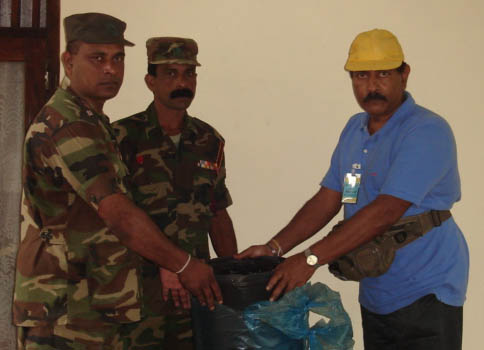 Next morning Anil gifted a large roll of Black Polythene at the Army camp as
a token of what was to come by train. Costing Rs25,000 each these Rolls are very useful to keep the Soldiers dry during the rainy season. We then drove toward Mannar to visit two IDP camps.
Next morning Anil gifted a large roll of Black Polythene at the Army camp as
a token of what was to come by train. Costing Rs25,000 each these Rolls are very useful to keep the Soldiers dry during the rainy season. We then drove toward Mannar to visit two IDP camps.
I can remember traveling this way by train in 1978 on my way to the Talaimannar Pier to catch the ferry into Rameshwaram. That ferry to India stopped few years later, but now even the railway line does not exist. All I saw was the bund and shells of Buildings that were formally rail stations. The Terrorists and subsequently the Army had used all of the rail tracks and sleepers to build bunkers. There were security bunkers every about 100 meters alternating on both sides of the road. This road had been the border after the 2002 cease fire agreement (CFA). Both sides of the road had been cleared and some of it was being brought under cultivation. Interesting the power-line was using barb wire connected along the posts used for the Telephone line. The electricity loss along the line is probably huge. We passed the road to Madu. The Gateway arch had been renovated, but the road was closed since that region had not been completely de-mined.
We were met by an army escort and just beyond Murunkan, as we left the main road and traveled south-west to get to the IDP camps. The first IDP camp Kalimoddai at Puliyankulam, served about 200 families with a total population of about 450. The camp had 50 large tents and about 100 cajan shacks, each about 300 square feet (25x12 feet). It had been operational for 8 months. In front of the communal Toilet were two large billboards put up by Sarvodaya, with illustrated instructions on proper use of Toilets, as well as personal hygiene.
We unloaded half of the powdered Milk for the ladies, Sarongs for the Men and Toys for the Kids that we had brought with us, and asked the camp residents to meet us in the community hall in which they could watched TV. S.L. explained the aim and source of this gift from the south and why we need to work as brothers of a single nation. A resident translated what was said in Sinhala into Thamil. Few of the residents felt they were being kept in captivity and asked when they could leave the camp. Others understood the security concerns.
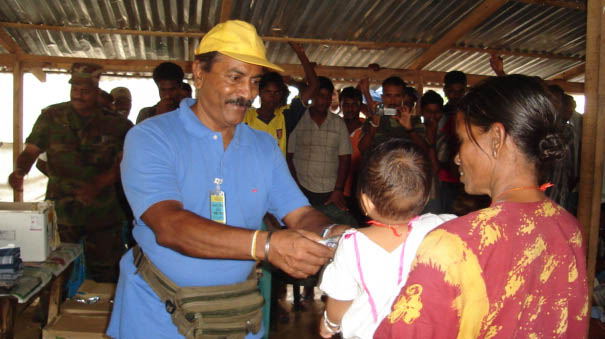
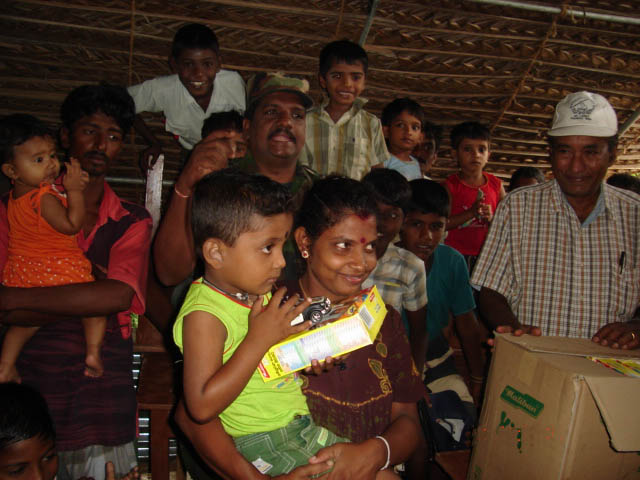
The generosity of the Lankan public in times of crisis is well known. The 2004 Tsunami was an example during which small groups organized themselves independently and traveled to the East and South of Lanka to help the needy. There was no coordination between the collection and the needs of the persons to whom the aid was given. Much of the aid was wasted, while they would have been of use at some other place. This time the ManelMal Movement has provided that central coordination.
While the battle is being won on the front-line, winning the war will required gaining the confidence of those who have been liberated from the Terrorists. After over 25 years of conflict most of the younger Tamil community in the North have grown up without any interaction with any Sinhala. Even in the south, the Sinhala students haven't had any of the opportunities that the older generation had of mixing closely with all communities. For the Urban youth the battles are only News items, sinc relatively far less of them have volunteered to join the armed forces. So the "Train of Brotherhood" which was an idea of Anil, served many needs. In addition to helping the IDP in camps, and the Soldiers on the front-line, this project gave the opportunity for the general public in the south to help those in the North. The awareness created among the public and their sensitivity to the cause, was amply measured by the very large collection made.
An edited version of this article Train of Brotherhood building bridges between north and south By Kavan Ratnatunga appeared in the Online edition of the SundayTimes of Sri Lanka on 2008 December 28th.